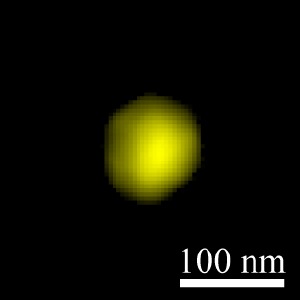Aug 30 2008
A team of scientists from the Technische Universität Dresden (Germany) and the ESRF in Grenoble (France) has produced the image of an object at the highest resolution ever achieved with X-ray light. A 100-nanometre gold particle fixed on a substrate was reconstructed with 5 nanometre resolution. Contrary to other techniques, X-ray imaging works also in real-life environments like chemical processing or in the presence of high magnetic fields. The team reports its findings in the newest issue of Phys. Rev. Lett. dated 5 September 2008 (published online 29 August 2008).
 Image of the gold nanoparticle as reconstructed from the diffraction pattern. The brightness is a measure for the thickness of the gold. Courtesy of C. Schroer/TU Dresden.
Image of the gold nanoparticle as reconstructed from the diffraction pattern. The brightness is a measure for the thickness of the gold. Courtesy of C. Schroer/TU Dresden.
Anyone who buys a camera knows that money spent on the lens is never wasted as a bad lens never delivers sharp images. A “good” lens to make images with X-rays is a big challenge as this must be manufactured 1.000 times better in quality than the lens of an optical camera or microscope. For this reason, the potential for high-resolution imaging with X-rays could not been exploited fully to date.
The trick is not to use a lens at all to record the image. Instead, the object is illuminated by a light beam and only “diffracted” light is recorded. Diffraction is the scattering of light at sharp edges and small obstacles, a good illustration of which is the spreading of automobile headlight beams by fog or fine dust particles. If the light has special laser-like properties, diffraction generates a regular pattern from which the shape of the object can be reconstructed by a computer programme. Many synchrotrons across the world offer this technique, called “coherent X-ray diffraction imaging”, but the intensity and quality of coherent X-ray beams limit the resolution to 30-40 nm.
The team from TU Dresden and the ESRF made a big step forward, pushing the resolution, i.e. the detail resolved in the image, from some tens of nanometres to five nanometres—which is 100 times sharper than what a very good optical microscope can achieve.
This was possible as the scientists improved both the quality and the intensity of the coherent X-ray beam as they focused an incoming 15.25 keV beam to a diameter of just 100 nanometres, whilst maintaining its shape pencil-like in order to guarantee laser-like properties. During ten minutes, the beam illuminated a single nanoparticle, after which a detailed diffraction pattern made it possible to render an image of the particle.
In the future of the ESRF, the technique of coherent diffraction imaging will take a big role. The Purple Book, the document describing the ESRF’s Upgrade Programme 2008-2017, highlights coherent diffraction imaging as a tool to be developed extensively. The technique is non-destructive and can assess the shape, size, strain and composition of individual nanostructures like quantum dots in semiconductors or nanoparticles in catalytic converters. Improved detector techniques and future free-electron laser sources would even make possible to take images of biological macromolecules which otherwise are too sensible to radiation damage.
Coherent X-ray diffraction is not the only technique to achieve nanometre resolution. Transmission electron microscopy, for example, yields the highest resolutions. It requires, however, thin samples to be put into vacuum. X-ray techniques can be used in nearly any possible environment, such as chemical reactors or high magnetic fields, and are also suited to study how a sample changes with the environment.
As the next step, the team plans to further push the resolution towards the nanometre-limit and to apply their record-breaking technique to answer some real-world scientific questions.